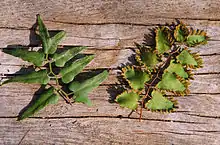Lygodium microphyllum
Lygodium microphyllum (commonly known as, variously, climbing maidenhair fern,[1] Old World climbing fern,[1] small-leaf climbing fern,[1] or snake fern[1]) is a climbing fern originating in tropical Africa, Southeast Asia, Melanesia and Australia.[1] It is an invasive weed[4] in Florida[5] where it invades open forest and wetland areas. The type specimen was collected in the vicinity of Nabúa, on the island of Luzon in the Philippines by Luis Née.[6]
| Lygodium microphyllum | |
|---|---|
 | |
| Underside of spore-bearing leaflets, some leaflets produce spores; others do not. | |
| Scientific classification | |
| Kingdom: | Plantae |
| Clade: | Tracheophytes |
| Class: | Polypodiopsida |
| Order: | Schizaeales |
| Family: | Lygodiaceae |
| Genus: | Lygodium |
| Species: | L. microphyllum |
| Binomial name | |
| Lygodium microphyllum | |
| Synonyms[1][2][3] | |
Distribution

Lygodium microphyllum is native to much of tropical Africa and South Africa; tropical Asia, including China, Ryukyu Islands of Japan; Australia; Fiji, the Mariana Islands and Caroline Islands.[1]
Lygodium microphyllum has become naturalized in the Caribbean and the southeastern United States.[1]
Effects on the environment
Lygodium microphyllum causes problems in the environments where it is invasive. The plant damages wetland ecosystems, harming endangered species.[8] The fern's ability to grow up and over trees and shrubs and to form dense horizontal canopies allows it to cover whole communities of plants, reducing native plant diversity. Old World climbing fern can grow in many diverse ecosystems.[9] Lygodium microphyllum poses problems for fires, both natural and man-made, because it can lead fire into the tree canopy, killing trees.[10] The fern rapidly spread in South Florida's public conservation lands.[9]
Containment
Recently, the USDA approved the use of insects to keep the fern contained. Insects (Austromusotima camptozonale, Neomusotima conspurcatalis) and mites (Floracarus perrepae) have been released in several state parks to control the fern. Although some populations were devastated by a bout of cold weather, recently, reports of new activity have been made.[8]
Ethnobotany
Lygodium microphyllum has been used locally in folk medicine to treat skin ailments and problems, swelling and dysentery.[11]
Other uses
Lygodium microphyllum fibers (as well as other species of Lygodium), known as nito, are used to weave traditional salakot hats in the Philippines.[12][13]
References
- Under its treatment as Lygodium microphyllum (from its basionym of Ugena microphylla), this species name was published first in Prodromus Florae Novae Hollandiae 162. 1810. "Lygodium microphyllum". Germplasm Resources Information Network (GRIN). Agricultural Research Service (ARS), United States Department of Agriculture (USDA). Retrieved November 2, 2011.
- Ugena microphylla, the basionym of L. microphyllum, was first described and published in Icones et Descriptiones Plantarum 6: 76, pl. 595, f. 2. 1801. "Ugena microphylla". Germplasm Resources Information Network (GRIN). Agricultural Research Service (ARS), United States Department of Agriculture (USDA). Retrieved November 2, 2011.
- "Name - Ugena microphylla Cav. synonyms". Tropicos. Saint Louis, Missouri: Missouri Botanical Garden. Retrieved November 2, 2011.
- "Global Fire Initiative: Fire and Invasives". The Nature Conservancy. Archived from the original on 2009-04-12. Retrieved 2008-12-12.
- Soti, Pushpa G.; Jayachandran, Krish; Koptur, Suzanne; Volin, John C. (2015). "Effect of soil pH on growth, nutrient uptake, and mycorrhizal colonization in exotic invasive Lygodium microphyllum". Plant Ecology. 216 (7): 989–998. doi:10.1007/s11258-015-0484-6. S2CID 17894584.
- "Name - Ugena microphylla Cav". Tropicos. Saint Louis, Missouri: Missouri Botanical Garden. Retrieved November 2, 2011.
- Volin, John C.; Kruger, Eric L.; Volin, Valeria C.; Tobin, Michael F.; Kitajima, Kaoru (2009). "Does release from natural belowground enemies help explain the invasiveness of Lygodium microphyllum? A cross-continental comparison". Plant Ecology. 208 (2): 223. doi:10.1007/s11258-009-9700-6. S2CID 38267539.
- Smith, Melissa C; Lake; Pratt; Boughton; Pumberton (June 2014). "Current status of the biological control agent Neomusotima conspurcatalis (Lepidoptera: Crambidae), on Lygodium microphyllum (Polypodiales: Lygodiaceae) in Florida". Florida Entomologist. 97 (2): 817–820. doi:10.1653/024.097.0268. JSTOR 24362579.
- "Weed alert: Old World climbing fern" (PDF). myFWC.com. Florida Fish and Wildlife Conservation Commission. Retrieved November 30, 2020.
- Rayamajhi, Min B; Pratt, Paul D; Leidi, Jorge; Center, Ted D (December 2014). "Austromusotima camptozonale ( Lepidoptera: Crambidae) herbivory results in frond and rhizome mortality of the invasive fern Lygodium microphyllum (Schizaeles: Lygodiaceae)". Florida Entomologist. 97 (4): 1308–1316. doi:10.1653/024.097.0405. JSTOR 24364092.
- James A. Duke. "Lygodium microphyllum (SCHIZAEACEAE)". Dr. Duke's Phytochemical and Ethnobotanical Databases. Retrieved November 2, 2011.
- Salakot and Other Headgear (PDF). ICHCAP, UNESCO.
- "Lygodium (PROSEA)". Pl@ntUse. Retrieved 3 March 2020.
| Wikimedia Commons has media related to Lygodium microphyllum. |
[1]External links
- Species Profile - Old World Climbing Fern (Lygodium microphyllum), National Invasive Species Information Center, United States National Agricultural Library. Lists general information and resources for Old World Climbing Fern.
- "Old World Climbing Fern (Lygodium microphyllum), a Dangerous Invasive Weed in Florida," American Fern Journal Vol. 88 No. 4 (1998)[2]
- Killer fern overruns refuge; agencies fight back, South Florida Sun Sentinel, 2018[3]
Bibliography
- Jeffrey T. Hutchinson, Kenneth A. Langeland, Gregory E. MacDonald and Robert Querns, 2010; Absorption and Translocation of Glyphosate, Metsulfuron, and Triclopyr in Old World Climbing Fern (Lygodium microphyllum). Weed Science 58:2, 118-125 Online publication date : 1-Apr-2010 (abstract)
- Pemberton, Robert W.; Ferriter, Amy P. (1998). "Old World Climbing Fern (Lygodium microphyllum), a Dangerous Invasive Weed in Florida". American Fern Journal. 88 (4): 165–175. doi:10.2307/1547769. ISSN 0002-8444. JSTOR 1547769.
- Pemberton, Robert W.; Ferriter, Amy P. (1998). "Old World Climbing Fern (Lygodium microphyllum), a Dangerous Invasive Weed in Florida". American Fern Journal. 88 (4): 165–175. doi:10.2307/1547769. ISSN 0002-8444. JSTOR 1547769.
- Fleshler, David. "Killer fern overruns refuge; agencies fight back". sun-sentinel.com. Retrieved 2020-05-11.
